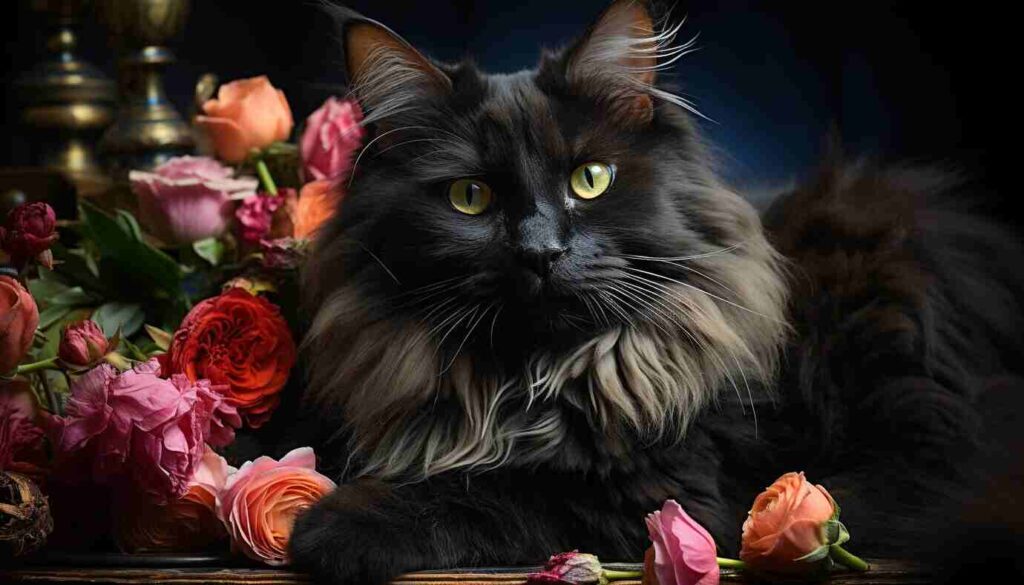
The Chantilly cat, sometimes referred to as the Chantilly-Tiffany, is an exquisite breed that is unique in looks, temperament, and history. With masses of handsome semi-long hair and huge expressive eyes, this breed has now found its way into the hearts of feline lovers as being gentle and loyal. From close to oblivion, this captivating feline has now survived courtesy of the propagators who are committed to its reproduction.
History of the Chantilly Cat
The history of the chantilly cat can be traced back to America in the North. There have been sightings of it beginning around the 1960s. The roots of this breed are quite a mystery as many hold the view it had been in Europe centuries ago before being transported to America. Some believe its relatives include the Burmese or some other long-haired breeds. Others believe it came from Australia.
The Chantilly is still classed as a rare breed today, with fewer breeding programs throughout the world. Even though it is rare, people love the Chantilly for its elegant looks and charming personality which makes it a desirable breed.
Physical characteristics of Chantilly Cat
Chantilly cats possess an outstanding coat which consists of silky plush and neck furs that elevate their appearance.
Size and Build:
This breed is considered medium and has a muscular body weighing between 6-12 pounds. The posture is elegant and the cats have long legs and a bushy tail.
Coat and Colors:
It was chocolate-colored when it was first introduced but can also be found in blue, lilac, cinnamon, fawn, and even platinum. Their coat is soft and requires mild grooming in regards to the coat becoming matted as it is almost semi-long.
Eye Color:
Their eyes are prominent and exquisitely shaped in an oval form. They range in color from gold, to amber but will naturally darken with time.
Personality and Temperament
Apart from their looks, Chantilly cats are known to win the hearts of many people due to their kindness. These cats are incredibly affectionate and connect well with their human family.
Affectionate:
It is not uncommon to refer to a Chantilly cat as a ‘velcro cat’ due to their tendency to stick to their owners. They love shadowing their human owners indoors and are known for their calm and loving behavior.
Social and Curious:
The environment around them is a playground of adventure for inquisitive Chantilly cats. Due to their amiable personality, they fit well in families and with pets.
Moderate Energy:
Although Chantilly cats are not hyper, they like it when people actively engage with them during play times, which means they can live in busy houses or quieter ones.
Health and Lifespan
Most Chantilly cats are healthy and do not have a life expectancy of less than 12-15 years, and when taken care of properly, some can live longer. Due to the breed’s rarity, detailed studies of health issues are not available but generally, they do not carry any genetically inherited disorders specific to the breed.
Common Health Concerns:
Chantilly cats can suffer from some forms of dental disease, more commonly, obesity if there is an imbalance in their diet as with many long-haired breeds.
Preventative Care:
A healthy lifestyle, and proper health insurance based on regular check-ups, oral hygiene practices, and dietary logs enrich the quality of life as well as the lifespan of the individual.
Diet and Nutrition
It is important to provide balanced nutrition in order to preserve the health of the Chantilly and its coat. These cats do well with offering the best cat food brands that are rich in protein, vitamins, and minerals.
High-Protein Diet:
The diet of Chantilly cats should consist mainly of animal protein as these cats are obligate carnivores. Always select a food brand that has meat as the first ingredient.
Avoid Fillers and Additives:
The same thing goes for dairy products, keep in mind that starches and sugars are common in cat foods and should be avoided.
Portion Control:
Especially in this breed, owners must follow feeding guidelines to prevent overfeeding as these cats are predisposed to obesity.
Chantilly Cat Care Tips

A semi-longhaired coating of the cat means average grooming to achieve and maintain a high appearance. All their needs are not as severe as those of long-haired breeds, but still quite basic.
Brushing:
The coat should be brushed about two to three times a week to discourage tangles and help contain shedding. During the season of shedding this may need to be done with dairying and Dental Care:
Cutting nails should be done regularly, in addition, placing dental treats will ensure oral hygiene since this helps in preventing periodontal disease.
Bathing:
Bathing is not required but once in a while can be done for policy purposes to maintain the coat’s sheen and the natural oils’ over-excessiveness.
Training and Socialization
Chantilly cats exhibit intelligence and can be trained rather easily due to the combination of their instincts and desire to please.
Litter Training:
Chantilly cats are relatively easy to litter train given that they are exposed to a litter box at a young age.
Basic Commands and Tricks:
These cats enjoy learning simple tricks, responding to their names, fetching as well as other simple commands.
Early Socialization:
Providing Chantilly exposure to other pets and people while still young is the greatest way to ensure that the adult cat will be social. Younger ages also allow to mitigate chances of timidity or anxiety when presented in new settings.
Chantilly Cats and Families
Having children or other pets should not scare families from adopting Chantilly since their calm and loyal character is perfect for families with children.
Children:
The Chantilly cats are very tolerant and can fit well in a family with younger children. Gentle actions are welcome, but they will stick to the younger ones.
Pet Compatibility:
There are generally no issues where Chantilly cats are concerned when they are around other cats or even friendly dogs as long as the introduction is done slowly. They do not mind other cats as much and are less vicious or territorial.
Attention Needs:
They are not very demanding of their owners or anyone for that matter but they do prefer receiving love and attention as well as playtime from their owners.
Chantilly Cat History in Detail
The history of the Chantilly cat is interesting and puzzling, especially since there is still much disagreement about the cat’s origins.
Early Origins:
In the beginning, it is believed that the Chantilly cats came from a breed that was first developed in Europe, possibly through the long-haired Burmese breed.
Re-emergence in the 1960s:
The breed was rediscovered in 1967 when a pair of chocolate-colored cats were found in New York. A breeder by the name of Jennie Robinson began inbred and developing the cats which led to what we call the Chantilly today.
Breed Decline and Preservation Efforts:
Sadly, the interest in the Chantilly breed began to fade in the early 1980s and the breed was nearly lost. Thanks to the efforts of some dedicated breeders, they have managed to keep the breed alive, although in extremely small numbers.
Current Status and Rarity

At the moment, it seems that the Chantilly cat is rescued and preserved, recruiting players whose specialty is utmost on the lookout for the rarest breeds in the world.
Limited Population:
Very few Chintillys have been ever bred each year.
Conservation Challenges:
Ever-breeding programs are encountered for management as too few potential owners are interested in the kittens for sale.
Where to Buy or Adopt a Chantilly Cat?
Because these breeds are rare, locating a Chantilly cat is not an easy task and one needs to be patient.
Breeders:
Very few breeders of the Chantilly breed exist around the world. It matters how many essays about the breeders with terrible reputations someone found because it means they will be mistreated and altered the lines of some cats.
Adoption Ideas:
From time to time, surely if not in order places, you can adopt Chantilly from breed-specific shelters or even general cat shelters. Adopting litter, yes there is one of Silk’s ethnic needs that can help get a home for such a Chantilly ma house.
Questions to Ask:
The first few questions made when buying a pet from a breeder are the active health history of the kitten. The parents of the infant, and a touched specialization if there are any.
Conclusion
It is safe to say that the Chantilly cat is an extraordinary and uncommon breed. People love it due to its silky fur, erring personality, and history. This breed is devoted and sociable. Chantilly adapts well in affectionate households appreciating its docile character and stunning looks. They may very well be difficult to locate but once you bring such one into your home, you will have an ever-loyal and affectionate partner. This rare gem of the catches has cat enthusiasts under their spell and is worth every bit of trouble recruiting for those who are on the lookout for an exceptional breed.
FAQs
The average life expectancy of Chantilly cats is about 12-15 years although with good care. It includes regular vets and a proper diet, many can live longer than this.
Yes, Chantilly cats are friendly and sociable creatures. These cats are therefore a good choice for families with kids and other animals. They are calm and tend to be sociable.
Chantilly cats benefit from moderate grooming since they have semi-long coats. You have to use brushes about two times a week. It will help you to keep their hair from becoming matted and to make it healthy and shiny.




